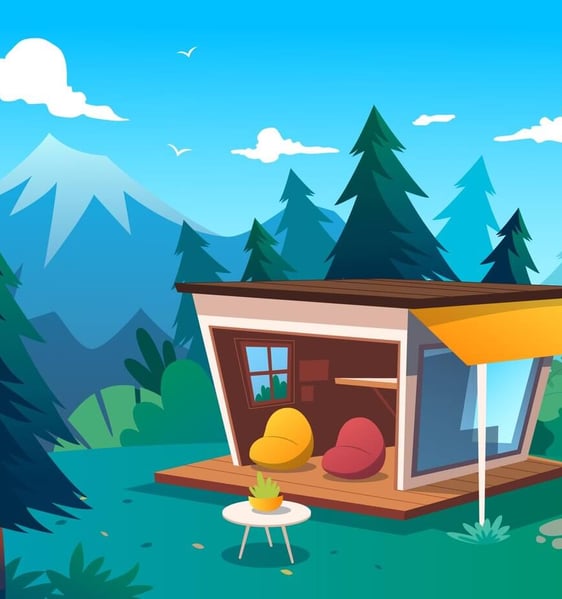Roto-Rooter Blog
Plumbing for Tiny Homes: Essential Considerations and Tips
The tiny home movement is gaining momentum, with many people opting for the simplicity and eco-friendliness of compact living. However, a vital element of tiny home design that demands meticulous consideration is plumbing. This article will delve into the distinct challenges and solutions related to plumbing in tiny homes, providing you with the necessary information to establish a functional and efficient plumbing system.
Understanding Tiny House Plumbing
Tiny house plumbing systems differ from standard plumbing due to their compact design and the constraints of limited space. Below are some essential components and factors to consider:
Water Supply and Management
Tiny homes often depend on municipal water connections or utilize off-grid systems, which include water tanks or wells.
A typical arrangement involves a freshwater tank, which may be situated either under the house or alongside it, linked to the plumbing system through pipes.
Wastewater Management
Wastewater from rainwater catchment on the roofs, sinks, showers, and toilets requires proper management. Many tiny homes utilize holding tanks for graywater, and blackwater systems often connect to either municipal sewage or septic tanks.
Comprehending local regulations on wastewater disposal is essential for ensuring compliance and upholding environmental stewardship.
Space-Saving Fixtures
Tiny homes, constrained by space, frequently employ compact fixtures like corner sinks, collapsible tables, and space-efficient shower stalls to optimize functionality while maintaining comfort.
Key Plumbing Components
Pipes and Fittings: PEX, or cross-linked polyethylene, is favored in tiny homes for its flexibility, simple installation, and freeze resistance. Conversely, PVC pipes are typically utilized for drainage purposes.
Water Heater: Tankless water heaters have gained popularity in tiny homes due to their space-saving design and ability to supply hot water instantly, thus removing the necessity for large storage tanks.
Drainage System: Ensuring proper drainage is crucial to avoid blockages and guarantee the effective removal of wastewater. This typically involves a mix of gravity-driven systems and pumps for fixtures that are situated above the main drainage line.
Installation Tips
Plan Your Layout
Prior to initiating the plumbing installation, it is crucial to meticulously plan the arrangement of your pipes and fixtures. Doing so will aid in preventing issues and guarantee an effective water distribution in your residence.
Utilize Vertical Space
In small living spaces, the vertical dimension is frequently overlooked. Installing wall-mounted fixtures, like sinks and shelving, can maximize the use of wall space for storage purposes.
Ensure Proper Venting
Proper venting is essential for the correct functioning of drainage systems. If venting through the roof is not an option, consider using air admittance valves (AAVs).
Insulate Pipes
In colder climates, it's crucial to insulate exposed pipes, particularly in unheated spaces, to prevent freezing. This measure helps preserve water flow and avert expensive damages.
Test Your System
Once installed, conduct a comprehensive test of your plumbing system to detect any leaks and ensure proper functionality. Activate all faucets, inspect for any drainage problems, and verify that the water heater is operating efficiently.
Maintenance Considerations
Regular Inspections: Regularly inspect your plumbing system to detect and resolve potential problems before they worsen.
Preventative Measures: Install drain screens to trap debris, refrain from disposing of grease in the sink, and routinely flush pipes with hot water to prevent clogs.
Emergency Preparedness: It's crucial to be prepared for plumbing emergencies by knowing how to turn off the main water supply and keeping the contact details of a trustworthy plumber handy.
Conclusion
While plumbing in tiny homes may appear challenging, it becomes manageable with meticulous planning and appropriate materials. Understanding the specific plumbing needs of tiny homes and applying effective strategies can lead to a functional and streamlined system tailored to your requirements. Whether opting for an off-grid setup or connecting to city utilities, the objective is to engineer a plumbing system that optimizes available space and reduces complexity. For any uncertainties in your plumbing project, seeking advice from a qualified plumber is advisable. This guide offers an in-depth look at plumbing for tiny homes, providing valuable advice and perspectives to assist homeowners in overcoming the distinctive hurdles of installing plumbing in small-scale dwellings.


50+
Expert Technicians
In Our Service Area
'We're the Clog Experts'
(video below)
'How to Test Your Water Heater's Temperature & Pressure Valves'
(video below)
Greater Rome, and Chattooga and Floyd counties, Georgia
(706) 235-7076



We offer precision drain cleaning, plumbing, and water restoration.
Skilled technicians deliver rapid and reliable solutions for all plumbing requirements. We offer plumbing solutions in Cartersville and beyond — serving Bartow, Chattooga, Floyd, and Gordon counties in Northwest Georgia. Your local plumbing experts are just a call away!
© 2024 Roto-Rooter Plumbing and Water Cleanup of Cartersville and Northwest Georgia. Operated as an independent Roto-Rooter franchise. All rights reserved.
Plumbing License Numbers:
GA: 788
Rest assured, our licensed professionals are fully qualified to handle all your plumbing needs in your northwest Georgia community.
